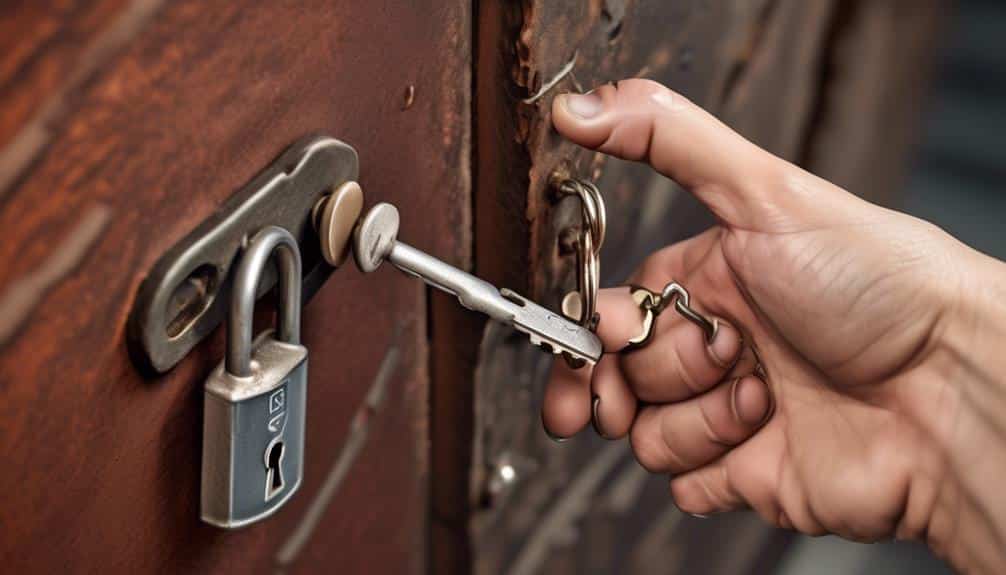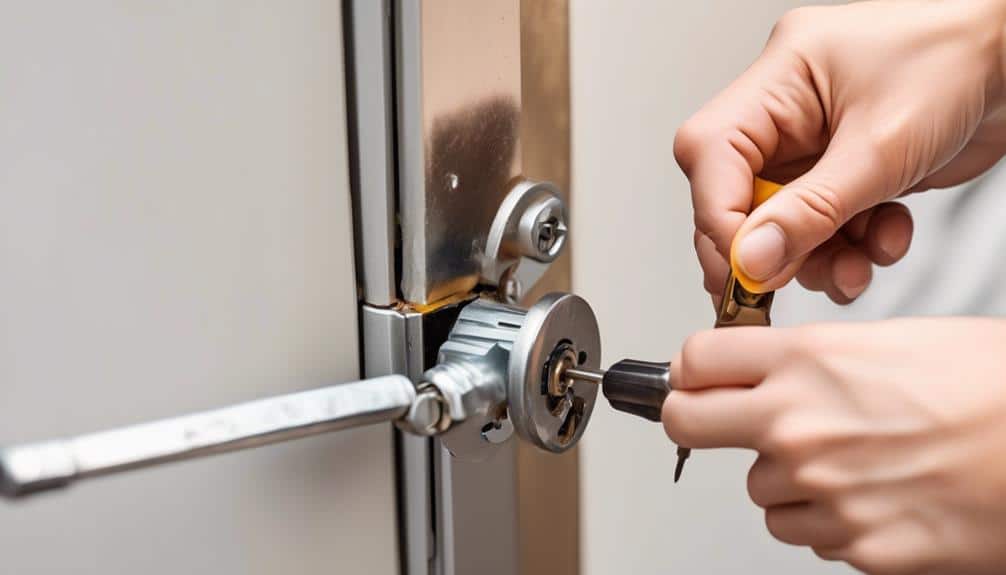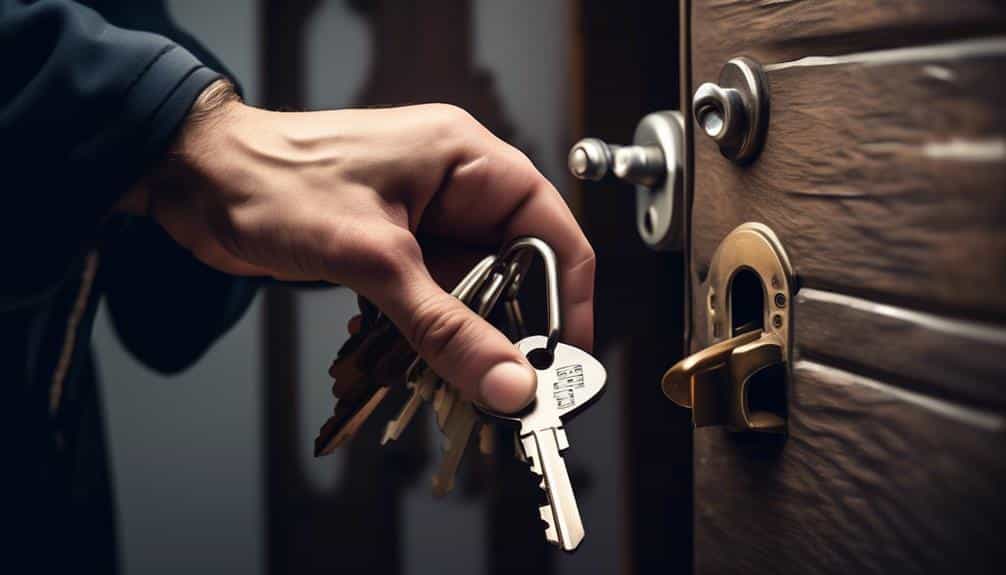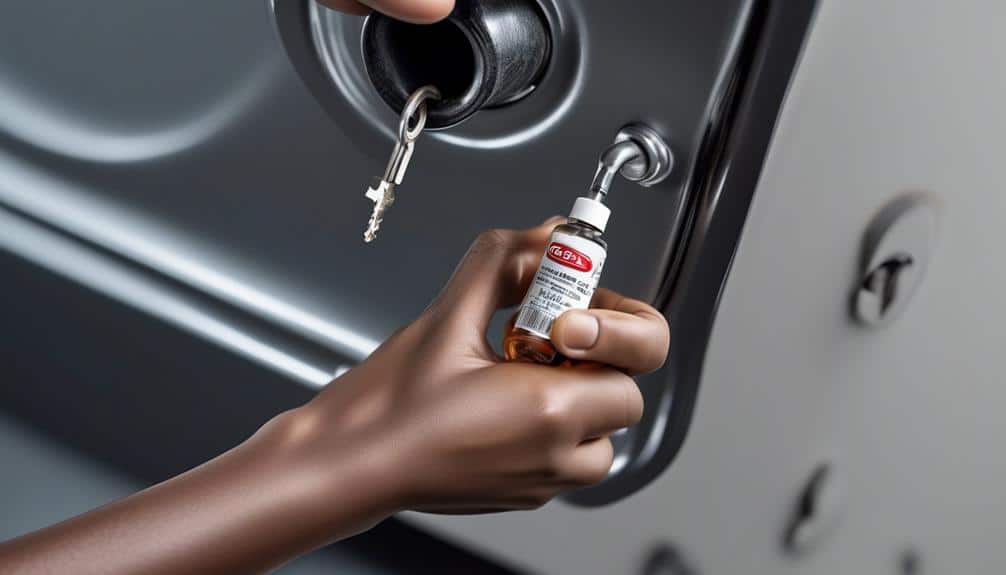Have you ever found yourself in a rush, only to discover that your key won't turn in the lock? It's frustrating, to say the least. Malfunctioning locks can happen at the most inconvenient times, leaving you feeling helpless and locked out.
But fear not, because in this discussion, we will explore the common causes behind these lock malfunctions and provide you with some practical tips on how to fix them.
So, if you're tired of being held hostage by a stubborn lock, keep reading to uncover the secrets of lock troubleshooting and maintenance.
Common Causes of Lock Malfunctions

Lock malfunctions can occur for various reasons, and understanding the common causes can help you troubleshoot and fix the issue efficiently.
One common cause of lock malfunctions is lack of lock lubrication. Over time, locks can become dry and the internal components may start to stick or become difficult to operate. This can result in key sticking or difficulty turning the lock mechanism. To fix this issue, it's recommended to lubricate your locks regularly with a graphite-based lubricant. This will help to keep the lock mechanism operating smoothly and prevent any unnecessary wear and tear.
Another common cause of lock malfunctions is weather-related issues. Extreme temperatures, humidity, and moisture can all have an impact on the performance of your locks. For example, freezing temperatures can cause the lock mechanism to become stiff and difficult to operate. On the other hand, high humidity or exposure to rain can lead to rust or corrosion, which can also affect the lock's functionality. To prevent weather-related lock issues, it's important to ensure that your locks are properly sealed and protected from the elements. Regular maintenance, such as cleaning and applying a protective coating, can also help to extend the lifespan of your locks and prevent any weather-related malfunctions.
Signs and Symptoms of a Malfunctioning Lock

Wondering how to identify if your lock is malfunctioning? Here are three key signs and symptoms to look out for:
- Difficulty inserting or turning the key: If you find it increasingly challenging to insert your key into the lock or if it becomes difficult to turn, it could be a sign of a malfunctioning lock. This could be caused by a broken key or an internal issue within the lock mechanism.
- Lock sticking or jamming: When your lock frequently sticks or jams, it indicates a problem with the internal components. This could be due to worn-out parts, dirt, or debris trapped inside the lock. Ignoring this issue may result in a complete lock failure and the need for a lock replacement.
- Inconsistent locking or unlocking: If you notice that your lock is inconsistent in locking or unlocking, it could be a sign of a malfunction. This could occur when the lock doesn't fully engage or when it doesn't release properly. It's important to address this issue promptly to avoid potential security risks.
If you encounter any of these signs and symptoms, it's advisable to consult a professional locksmith. They can assess the problem and provide you with the appropriate solution, whether it's repairing the lock or opting for a lock replacement.
DIY Fixes for Malfunctioning Locks

If you've noticed any of the signs and symptoms mentioned earlier, you may be wondering what steps you can take to fix a malfunctioning lock on your own. Fortunately, there are a few DIY fixes that you can try before calling a locksmith.
One common issue that can cause a lock to malfunction is a broken key. If you insert a key into the lock and it breaks off, it can be frustrating and leave you unable to unlock your door. To fix this, you can try using a pair of needle-nose pliers to carefully remove the broken key from the lock. Be sure to grip the key near the base and pull it straight out to avoid causing further damage.
Another DIY fix for a malfunctioning lock is to use lubrication techniques. Over time, locks can become stiff and difficult to turn. Applying a lubricant can help to loosen up the internal components and make the lock easier to operate. Before applying any lubricant, it's important to check the manufacturer's recommendations to ensure that you are using a suitable product.
Here's a table summarizing the steps for fixing a malfunctioning lock:
| Fixing Method | Steps to Follow |
|---|---|
| Removing a broken key | 1. Use needle-nose pliers to grip the key near the base. |
| 2. Pull the key straight out to remove it from the lock. | |
| Lubrication techniques | 1. Check the manufacturer's recommendations for suitable lubricants. |
| 2. Apply the lubricant to the lock, following the instructions. |
When to Call a Professional Locksmith

When encountering a lock issue that's beyond your DIY fixing abilities, it's time to reach out to a professional locksmith. While it can be tempting to try and solve the problem yourself, certain lock issues require the expertise of a trained locksmith. Here are three situations where calling a professional locksmith is the best course of action:
- Complex Lock Problems: If you're facing a lock issue that's intricate or involves advanced mechanisms, it's best to leave it to the professionals. A skilled locksmith has the knowledge and tools to handle even the most complex lock problems efficiently and effectively.
- Locksmith Services Cost: While it may seem like calling a locksmith is expensive, attempting to fix the lock yourself can sometimes lead to further damage and more costly repairs. Additionally, professional locksmiths offer competitive pricing and transparent quotes, ensuring that you receive quality service at a fair price.
- Emergency Locksmith Services: Lockouts or lock malfunctions can happen at any time, day or night. In these urgent situations, an emergency locksmith service can provide prompt assistance. They're available 24/7 and can quickly resolve your lock issues, giving you peace of mind and restoring your security.
Preventive Measures for Lock Maintenance

To ensure the longevity and functionality of your locks, it's important to implement preventive measures for lock maintenance. Regular cleaning and proper lubrication techniques are key to keeping your locks in optimal condition.
Regular cleaning is essential for preventing dirt, dust, and debris from accumulating in your lock mechanism. Over time, these particles can cause friction and hinder the smooth operation of the lock. To clean your lock, use a soft brush or a can of compressed air to remove any buildup. Be sure to avoid using harsh chemicals or excessive force, as these can damage the lock.
In addition to regular cleaning, lubrication is crucial for maintaining the performance of your locks. Applying a lubricant, such as graphite or silicone-based sprays, to the keyway and other moving parts of the lock will help reduce friction and ensure smooth operation. Remember to follow the manufacturer's instructions and avoid using oil-based lubricants, as they can attract dirt and debris.
Frequently Asked Questions
Can Malfunctioning Locks Be Repaired on Their Own, or Is It Always Necessary to Call a Professional Locksmith?
You may think you can handle a malfunctioning lock on your own, but let's be honest – it's not always that easy. While there are some temporary lock fixes and DIY lock repairs you can attempt, it's often best to call a professional locksmith.
They have the expertise and specialized tools to properly diagnose and fix the issue, ensuring your lock is secure and functioning correctly. Don't risk further damage or a lack of security – leave it to the pros.
Are There Any Temporary Fixes for Malfunctioning Locks That Can Be Done Until a Locksmith Can Be Called?
If you find yourself with a malfunctioning lock and can't immediately call a locksmith, there are some temporary fixes you can try.
One option is to lubricate the lock with graphite or WD-40 to see if that helps.
Another solution is to use a credit card or a thin piece of plastic to try and jiggle the lock open.
However, keep in mind that these are only temporary fixes and it's always best to eventually call a professional locksmith for a more permanent solution.
How Often Should Locks Be Inspected and Maintained to Prevent Malfunctions?
Inspecting and maintaining your locks regularly is crucial to prevent malfunctions.
You might be thinking, 'But how often do I really need to do this?' Well, let me tell you, the frequency of lock inspections and maintenance is of utmost importance.
By making it a habit to check your locks periodically, you can identify any potential issues and address them before they become major problems.
Are There Any Common Household Items That Can Be Used to Fix Minor Lock Malfunctions?
Homemade lock repair: Effective or risky?
When it comes to fixing minor lock malfunctions, you might be tempted to try using everyday household items as unconventional solutions. While some people have found success with these methods, it's important to approach them with caution.
Using items like bobby pins, toothpicks, or even credit cards to fix locks can be risky. They may temporarily solve the problem, but they can also cause further damage or even render the lock useless.
It's always best to consult a professional locksmith for any lock repairs to ensure safety and effectiveness.
Can a Malfunctioning Lock Be a Sign of a Larger Security Issue in the Home?
If you're dealing with a malfunctioning lock, it's important to consider the possibility of a larger security issue in your home. Signs of a larger security issue could include frequent lock malfunctions or difficulty in locking and unlocking your doors.
Don't ignore these warning signs as they could indicate a potential vulnerability in your home's security. Timely lock repairs are crucial to ensuring the safety and protection of your property and loved ones.
Don't delay in addressing these issues to maintain a secure living environment.


